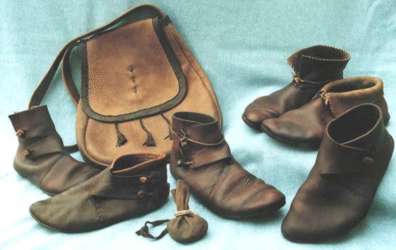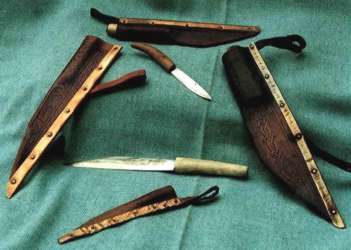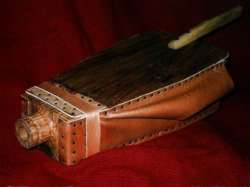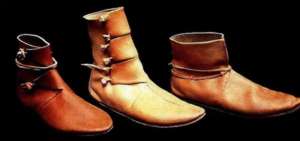 |
Unless you have very strong political views, just about everyone today has some items made using leather. Over the ages it has been used for boots, clothing, shields, and armour, tents, bottles buckets and fire hoses. In the Saxon period it was even more widespread as they did not have any of the other flexible materials we have today, but despite these innovations, it is still in great demand for good shoes, saddles and harnesses, suitcases, handbags, wallets, upholstery and many other high-quality products. The characteristics of leather were just as important then as they are today; flexibility, strength and durability.
The craft of the tanner, without whom no leather would exist, can be traced back for the better part of 500,000 years. The Ice Age was survived largely due to the ability to skin with fine flint scrapers and preserve pelts and hides. Skins will soon rot and fall apart unless they are preserved in some fashion. Smoking and stretching them is one way to temporarily stave off the inevitable rotting of the flesh. The next improvement is to rub fats and in particular the brains of the hapless animal into the hide to soften and make the leather pliable. The leather processing patent of smoking and oiling with brains was only registered as recently as 1914. The skin could have an oily substance like tallow (animal fat), egg yolk or dubbin which is a mixture of fish oil and tallow rubbed in to it's surface. It could also be treated by rubbing salt, brain or potash alum into the surface to produce a very pale leather. Both these methods were quick and easy but if the leather got wet the oils or minerals could be washed out and the leather would begin to carry on the rotting process.
It is unknown as to exactly when the method of using the bark of certain trees was to date the best way of transforming skins into the leather we today still recognise. This dark liquor is made miraculous because of the inclusion of the chemical Tannin. Whether it was an accidental or strangely purposeful discovery know one can say, but finds of leather have been made dating back at least 7000 years in the Middle East (which is the ideal place to find old leather by comparison to the more soggy and temperate North).
The use of Oak bark as the basis for tanning in Northern Europe lasted until the beginning of the 20th century, when the work of two Americans helped to speed up the process from two to three weeks, as opposed to the older method which could take a year or longer. Augustus Schultz the chemist and Robert Foerderer the sales end of things, developed 'chrome' tanning (using not surprisingly chromium salts). Because of the speed of manufacture, this method soon eclipsed the traditional process, almost killing off any of the tanneries who tried to remain faithful to the baths of tannin.
It is recognised the world over that tannin based leather production makes a superior leather of the highest quality.
 |
Leather was used for a variety of things during the Anglo-Saxon period including shoes, belts, pouches, saddles and bridles, ropes, scabbards, shield coverings, bookbindings, cups, bottles and bags. Garments such as cloaks, hoods and jerkins could be made, and if these were then oiled using fish or vegetable derived oils to make them waterproof. Presumably blacksmiths and other metal workers would have worn leather aprons, although there is no direct evidence for this.
The production of leather from animal hides was a time consuming and dreadfully smelly process. So much so that tanneries were often situated far out of town for reasons of air pollution rather than health. Leather only works as it does not hold water in it's pores, evaporating the water off leaving an air porous layer that helps in the case of feet to insulate them. If water somehow remains in the skin, the collagen protein fibres will begin to break down and rot. The hides of cattle, sheep, pigs, goats and deer, and perhaps horses, were all used. Once the animal was slaughtered, the skin was removed and the first job was to remove any excess bits of flesh and fat. In order to do this the hide was soaked and pounded and placed over a wooden beam where it was scraped with a special knife. If the hair on the skin were to be removed, urine, quicklime or wood ash was use in solution into which the hide was steeped and then rubbed or left to soak into the wet surface. This loosened the hair and allowed it to be scraped off with a tool today known as a 'scudder'. The hide was then washed to stop the chemicals affecting it further. At this point the hide is now technically a pelt, and it is now that it is judged as to what purpose the pelt should be put to. The more thickness, the more likely it is to become harness etc.
After the hair and fat had been removed, the tanner had to prevent the pelt from stiffening or rotting in one of several ways, as up to this point, it is white and very slimy and should be referred to as raw-hide. If removed from the steeping pits, the raw-hide would begin to dry rapidly and shrink, the properties of which were useful for some tasks.
Some of the pelts were then removed from the 'liming pits' and placed into vats containing a nauseous brew dog dung, chicken and dove droppings which 'fluffs' open the pores in the skin due to bacterial action and neutralising the lime, a process called 'bating' the leather. This makes the leather soft and pliant, and suitable for such things as clothing. The amount of bating that the leather underwent, controlled how flexible the hide was to be. The pelts will them spend a few hours in a pit containing ammonia, once derived from urine, de-liming them further and them from here they go into the pits holding the tannin liquor. The weather and the volume of new bark affected the strength of the liquor and was always judged by experience. In turn, the number of pelts and age of the liquor determined how long they should spend in the pits soaking, all of which were certified by the tried and tested method of dipping your finger in and tasting it. The pelts were hung over a pole in the case of a deep pit or stacked in layers in a shallower clay lined pit and soaked in this mixture of water and crushed oak bark (the prime source of the tannin). There were several pits through which the pelts were rotated, each containing an increasingly stronger strength solution. The tannin is relatively a weak solution, and time alone is the only way to work it right through the structure of the leather. The action of the tannin is to preserve, driving out the pelt's water content which makes up 70% of the pelt's weight, and coating each and every one of the collagen fibres with tannin. Tannin helps the leather to resist the effects of heat, decomposition by water and attack by all manner of organisms.
The bark was sourced from ideally trees felled as the sap in them was rising in the spring months, which also made their stripping easier as well. The strips were cut into lengths around the two foot mark for ease of handling, before being dried and then ground down and mixed with water. Elm, Willow and Alder are also good sources of tannin, but Oak has for a very long time been the traditional choice.
 |
The pelts are handled about once a week, and make their way through the first series of pits in about three months. They next go to the layer pits to sit for ten months or so with layers of crushed bark between them. Cords are tied to the corners of the pelts so that they can be lifted to judge their progress, and moved from time to time. Only after this, are the pelts pulled out and strung out to dry and scrubbed, a process now done by large centrifugal drums to rid the leather of any water.
The finishing of the leather began with applications of traditionally Cod oil being applied and rubbed in with a thick wad of sheepskin. This helps to keep the leather supple, protects against the atmosphere and the addition of doing this in the shade prevents sunlight from making the leather dark and brittle (even with fully finished leather, the sun can in effect tan it and stain a perfectly good piece of leather. Unlike in humans, the process is not reversible.). From this point, the finishing of the leather has changed a great deal. Today, machines trim and cut the thickness and polish the leather. A thousand years ago, all this had to be done over a smooth beam with a series of tools by a man who became known as a 'currier'. The hardest part was to trim the leather to a single thickness, producing a lot of 'suede' waste. The leather then had to be polished with bone tools on it's outer surface, and extra applications of Cod oil rubbed over the hide. For a really fine finish, the currier might spend hours per hide, and is a very skilled and onerous task. The applications of Cod oil are there to replace natural skin oils that are lost due to the caustic nature of the tanning process. Only after many hours of finishing the surface, was the leather ready to be used.
At this point, the leather can be further enhanced by staining with liquor from other tree barks such as alder, possibly plant dyes or more Cod oil and extra 'slicking' with bone tools, and to act as a final layer, a blend of mutton fat, tallow (unhelpfully, technically any kind of fat, even vegetable fat), and yet more Cod oil darkening and preserving the surface.
Now that the leather was tanned and dried, it could be cut and stitched into the items required. In order to sew the leather, particularly thick leather, holes were made with an awl (a needle was not strong enough to puncture the leather) and it was then stitched with a needle or pig bristle using beeswaxed linen, wool or even gut thread. The seams of shoes were sewn in a variety of methods with either a single needle or two needles at the opposite ends of the same thread - a stitch known as 'saddle stitch'. The awl cuts a tidy hole in the leather that will close up tight around the thread as it is sewn, leaving a watertight stitch. The beeswax on the thread helps to preserve the thread and eases it through the hole as it is drawn through. Leather items were often decorated by tooling and painting. The tooling was done by damping the surface of the tanned leather and pressing or sometimes stamping the design in with a fairly sharp metal, bone or wooden tool. This engraves the surface rather than cutting it. The leather was also occasionally dyed and possibly painted to highlight the designs.
 |
The commonest leather finds are the soles of shoes. A new shoe might only last a few months before it needed to be repaired and most shoes found have been patched in some fashion. Even after repair they might only last a few months more. Because of this, shoes were rarely decorated, and in the worst conditions such as ploughing, shoes were dispensed with for the time being. Shoes were usually made by the 'turn shoe' method which involves stitching the shoe together inside out, and in such a way that the stitching does not pierce the outer surface of the leather. (Technically known as 'tunnel stitching'.). Once the shoe is finished it is turned the right way out, sometimes with the leather wet to ease the righting of the shoe. This method of construction has the advantage that it does not leave any exposed stitching on the outside of the shoe, prolonging its useable life.
The rawhide mentioned earlier is much stiffer and stronger than ordinary leather and could be used for edging and facing shields, making 'emergency' shoes, or any other job requiring a stiffer, stronger material. Like leather, it could be softened by soaking for ease of working, but would become hard and shrink as it dried. It has the propensity to suck up moisture unless it is proofed in some manner with a shellac of some sort.
The skin could also be tanned in such a way as to keep the hair on the skin. The time of year that the animal was killed has a bearing on how well the hair stays in the skin, making trapping in the winter the best time to hunt for pelts. These furs could then be used for trimming clothes, lining cloaks, as sleeping mats and blankets, and perhaps even for items such as sleeping bags. The wearing of skins as normal clothing was unknown for both the Saxons and the Vikings. We don't know for sure quite why this is, but it may lie in the fact that it may have been deemed 'barbaric' to do such a thing when there was perfectly good woollen and linen clothing to wear. Most people rarely had the chance to hunt animals for pelts anyway, leaving it to the 'idle rich' to do the hunting of large game purely for the pelt.
As an aside, a story from the 1950's in central Africa, relates how the skin of an Eland (the largest antelope) was cut into a spiral, and then draped over a branch from a tall tree. The thong was then tied to a large boulder and spun. After some hours, the action of the spinning boulder pulling down on the leather, the sun and the application of fat, created a rope when made up that could 'pull a five ton truck out of the mud'.
Click here to return to the village.